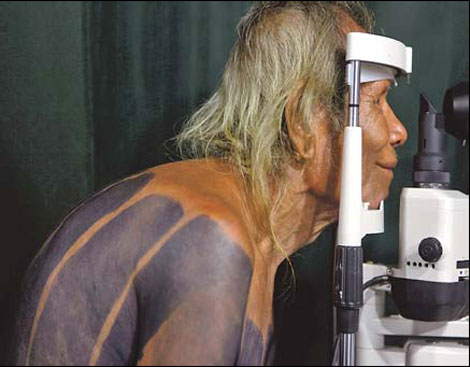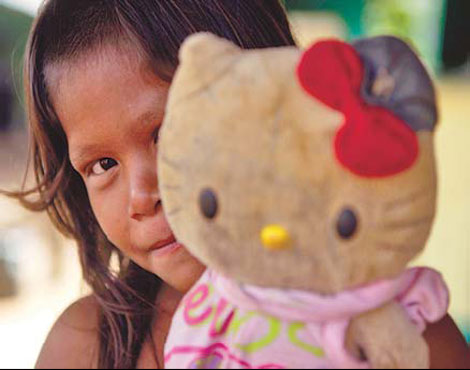Kayapo comeback
|
Kypato Kayapo, chief of a Kayapo tribe in northern Brazil, receives post-cataract surgery care from Expedicionarios da Saude volunteers. The Brazilian health organization sends doctors and health workers twice a year to remote regions to serve indigenous people. Photos by Reuters |
|
Traditional body paint links local youths to the memory of ancestors. Photos by Reuters |
|
Kayapo tribesman undergoes an electrocardiogram in the hospital of the Expedicionarios da Saude. Photos by Reuters |
|
A Kayapo boy takes pride in his traditional body paint and piercing. Photos by Reuters |
|
For the young, simple pleasures means a make-shift swing. Photos by Reuters |
|
Hello Kitty shows off its universal appeal. Photos by Reuters |
|
On the last day of their visit, a health team volunteer takes time off to play with a Kayapo child. Photos by Reuters |
An Amazon basin people finds ways to survive and thrive as a modern world encroaches on old ways.
They choose to live in the land of their ancestors, although they have been forced to adapt and work with encroaching influences. The Kayapo people of the Brazilian Amazon basin tell a story of resilience and perseverance.
Their first contact with outsiders was with Europeans about 500 years ago. Since then, as urbanization spread and started pushing into the rainforests, the Kayapos have been forced to go further inland. They have also suffered from introduced infections and diseases.
But they are a people with the talent to adapt.
To protect their rainforest habitat, the Kayapo have worked with celebrities and commercial groups to promote awareness of the environment, and their partners include rock-singer activist Sting and the late Anita Roddick of The Body Shop.
Kayapo culture is rich and colorful, with the use of face and body paint to imitate animal or insect markings, including those of bees. Women shave their heads, carving a distinctive V into the scalp, while men prefer flamboyant headdresses with a spray of feathers. Colorful ceremonies mark the passing of the seasons as well as rites of passage among men and women.
China Daily
(China Daily 05/08/2011 page6)





















